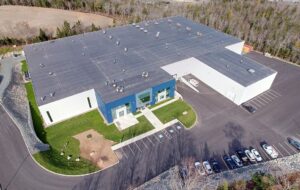Charlotte Hebebrand, is director-general of the International Fertilizer Association (IFA), a nonprofit organization that represents the global fertilizer industry, on issues related to the promotion of plant nutrients, improvement of the operating environment of the member companies and the collection and compilation of industry information. We caught up with her to find out how the industry is reacting to the wealth of new innovation coming into the sector.
Can you give us an insight into the current state of the fertilizer industry?
The consumption of fertilizers has grown nearly six-fold between 1961 and 2015 (from 32 to 184 million nutrient tonnes), to keep up with a population expanding from 3.1 billion to 7.4 billion during the same period. Today, fertilizers feed about 50% of the world’s population which amounts to around 20 billion meals per day.
In 2014, the combined value of the production of nitrogen, phosphate and potash raw materials was estimated to be $302 billion, while the sales value of products sold by fertilizer companies was $172 billion.
Fertilizers are by far the largest sector of the input market, compared to estimated current sales volumes of global crop protection at around $60 billion, crop seed and biotech at $45 billion, and biologics at $5 billion. Between 2015 and 2019, the global fertilizer industry is estimated to have invested between $86 and $91 billion in new mines and fertilizer-producing facilities, with a similar amount of investment occurring between 2010 and 2014
The fertilizer industry also makes a major contribution to employment and is responsible for almost one million jobs in production around the world, plus significantly more when also accounting for indirect jobs.
What is the biggest challenge for fertilizer use?
The environmental footprint of fertilizers – both in terms of production as well as application – must shrink, but this cannot happen at the expense of higher agricultural yields, considering that we may have close to 10 billion people to feed by 2050.
The bulk of the fertilizer industry’s energy demand, approximately 87%, is used for the production of ammonia using natural gas or other hydrocarbon feedstocks such as coal, to produce nitrogen-based fertilizers through the Haber-Bosch Process. While production plants built today with the most advanced technologies use 30% less energy per tonne of ammonia produced compared to older plants, the process remains energy intensive given the widespread use of fossil fuel feedstocks. Using techniques such as hydrolysis, powered by renewable energy, to produce so-called “green ammonia” could be a huge breakthrough, and may come into reach as renewable energy becomes more affordable.
On the application side, to make fertilizer more sustainable, it is vital to improve nutrient use efficiency (NUE): the ratio between input of nutrients and output in terms of the nutrients taken up in the harvested crop. By increasing yields on existing farmland, higher NUE can help further preserve wild ecosystems, increase carbon capture through soil organic matter and reduce the estimated 1.5% of global greenhouse gasses that are currently produced by fertilizer application.
According to the EU Nitrogen Expert Panel, an optimal NUE should be in the range of 50%-90%, while the average global NUE is currently around 45%-50%. Although some cropping systems in West Europe, Brazil, the US and Japan currently achieve around 70% NUE, other countries, such as China still have relatively low NUE, although it has already been improving for almost a decade. it’s important to keep in mind that a very high NUE (above 90-100%), such as we see in many parts of Sub Saharan Africa, signals that more nutrients are being removed by crops than introduced into the system, which leads to nutrient mining and poor soil health.
NUE needs to be improved by digital tools to help fertilizer decision-making and application, using climate-smart fertilizers that show enhanced efficiency, and, in the case of some regions such as sub-Saharan Africa, by ensuring greater access to fertilizers, to help all farmers achieve the 4Rs of Nutrient Stewardship: applying the Right nutrient source, at the Right rate, at the Right time, in the Right place. The 4Rs can be greatly facilitated by precision ag tools such as digital platforms, sensors and artificial intelligence, which can all help to improve fertilizer recommendations and more precise and targeted fertilizer application.
What is the fertilizer industry’s approach to R&D?
While we do not have precise figures, the fertilizer industry is often seen as investing significantly less in R&D compared to other input industries, explained in part by the fact that it is still largely a commodity business.
An increasing number of fertilizer companies are beginning to invest into non-traditional segments like biologicals and digital tools, however, as they look to become full-service plant nutrition solution providers. Recent examples include:
- In April 2018, Nutrien launched a digital ag platform to help farmers better manage the timing of planting, fertilizer application and harvesting using weather and soil data. Since then the company has made seven additional major acquisitions and partnerships including several biologicals and digital AgTech firms.
- In November 2017, Yara acquired the maker of Adapt-N, a computer modeling system that predicts precise crop application rates using weather data, field conditions and best soil management practices, to reduce nitrogen application rates and losses while increasing yields. And this year, Yara launched Yaralrix, a precision farming tool that allows farmers to measure crop nitrogen requirements with portable testers that connect to smartphones to make recommendations, as well as a partnership with IBM.
- In June 2018, Morocco’s state-owned phosphates company OCP acquired a 20% stake in Fertinagro Biotech, which manufactures and supplies a wide range of plant nutrition solutions, to bolster their know-how in product customization and innovation. The producer has also founded the agriculture-focused Mohammed VI Polytechnic University, opened in 2017 in Morocco, which provides university scholarships for African agricultural and environment engineering students. In June this year, it launched a startup acceleration program for Agtech, Biotech, Nanotech and MiningTech entrepreneurs.
- In 2012, Israeli fertilizer and specialty chemicals company ICL launched ICL Innovation to accelerate the development of sustainable new products which announced a collaboration agreement with PlantArcBio earlier this year for the development of innovative crop productivity enhancers for agriculture. In May 2018, ICL announced an investment and partnership with ag analytics firm CropX as part of its strategic decision to invest in and develop precision ag solutions.
- US group Koch Agronomic Services has been focusing on biologicals for a few years with the acquisition of the biological research and development business of Mendel Biotechnology in 2014 and by taking a minority of stake in microbial science company Pathway BioLogic in 2016.
What new innovations are cropping up in the fertilizer industry?
The range of agtech startups presented at the inaugural Plant Nutrition Startup Showcase during IFA’s Annual Conference in June with significant interest from IFA members helped to highlight the numerous possibilities for innovative products to improve NUE.
There is considerable potential in developing new fertilizer products and techniques that better synchronize nutrient release with plants’ needs. Researchers at the University of Adelaide, for example, have developed a new material that offers both fast and slow release boron to better match the needs of crops, as well as a manufacturing process that increases the solubility of zinc in fertilizers, improving crops’ early growth.
Another area is new materials to help nutrient delivery, such as nanoparticles and graphene, as well as solutions that help with the fourth aspect of the 4Rs, namely the right place for fertilizer application. Replenishing soil nutrients by placing fertilizers in depths of 20 to 60cm, known as subsoil fertilization, for example, can potentially increase yields from 50 to 100%, according to studies, so developing methods for affordably delivering fertilizers to those depths could be very significant.
In addition to precision ag tools to further improve fertilizer efficiency, other areas with potential for innovation include products that can improve plant resilience to flooding and droughts, organo-mineral offerings that combine organic and mineral fertilizers, and products mixing mineral fertilizers with biologicals and biostimulants.
On the production side, the industry is also developing techniques to produce “green ammonia” entirely from sustainable, carbon-neutral inputs, like biomass or renewable electricity. With a number of pilot projects currently in operation focusing on electrolyzers, and next-generation technologies such as electrochemical processes, photocatalytic devices, and advanced nuclear concepts being developed, the industry may in the future be producing low-cost, carbon-neutral nitrogen fertilizers.
Nutrient recycling is another growth area, with the fertilizer industry and many start-ups actively pursuing phosphorus, potassium and nitrogen recycling to support sustainable agriculture and the circular economy. The major objective needs to be to develop fertilizers from recycled nutrients that have a higher than normal and more consistent nutrient concentration than traditional organic fertilizers, making them more economical to move over larger distances.
Several plant scale trials from producers including ICL are already under way to replace mined phosphates by recovering phosphorus from a variety of ash materials. These secondary sources of phosphate include meat and bone ash, sewage sludge ash and struvite (containing between 20 and 35% P2O5). Wastewater nitrogen recovery facilities have also been built by producers such as Yara.
How do you see the future for fertilizer use and for the fertilizer industry?
We expect the environmental footprint of fertilizers to come under increasing scrutiny with growing pressure and new regulations from governments to improve NUE. This is already happening in developed as well as developing countries and may accelerate further in line with initiatives coming from the United Nations. Efforts by the fertilizer value chain and other stakeholders to help farmers improve their nutrient management performance are anticipated to produce a steady enhancement of the average global NUE.
It is hard to generalize but, in some regions, where fertilizers may be overapplied, as farmers become more efficient at using fertilizers, the demand in terms of nutrient tonnes may slow down. On the other hand, the need for more balanced nutrition, which includes all the major, secondary and micronutrients, provides for tremendous growth opportunities. Moreover, fertilizer demand will need to increase in some regions, which are under-fertilized, such as parts of Africa, Latin America, Eastern Europe and Central Asia.
There is also great scope for using micronutrient fertilizers to address micronutrient deficiencies not just in soils, but also in humans and animals. Applying micronutrients to soils is considered to be one of the most promising ways to fight malnutrition and alleviate nutrient deficiencies worldwide, especially for zinc, selenium and iodine. This method has been shown to be particularly effective for increasing the concentration of zinc in grains.
The fertilizer industry will increasingly focus on value over volume and look to offer a range of products and services to improve not only agricultural yields, but also plant, soil and human health.




